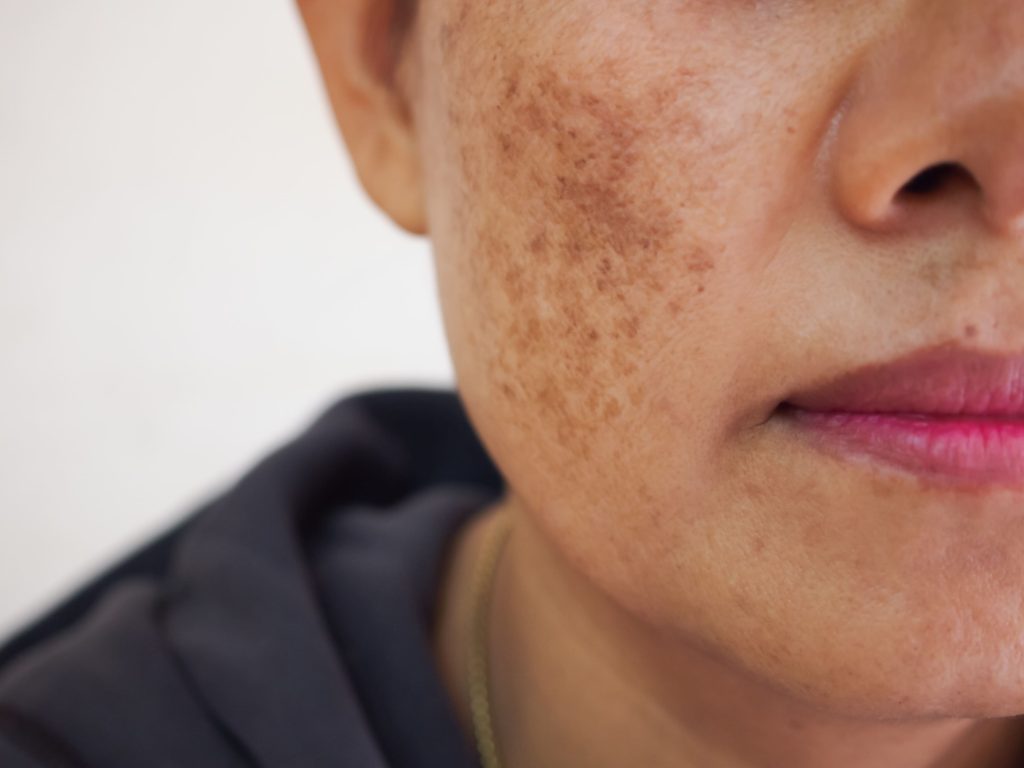
A tan is caused by exposure to ultraviolet (UV) radiation from the sun (or tanning beds). The UV radiation causes DNA damage to the cells in your skin, and that DNA damage then stimulates the pigment pathway to produce pigment in the skin (a.k.a. melanin). The pigment production results in skin darkening, or what we refer to as a “tan”. The melanin production is your body’s method of protecting the DNA against further injury by subsequent UV exposure. The pigment pathway also stimulates the pigment involved in sunspots and melasma. Sun damage, or the accumulation of DNA damage from sun exposure, is cumulative, starting from the very first tan.
Sun spots, or solar lentigines, are flat areas of darkened skin. They result from exposure to UV radiation which results in a proliferation of melanocytes (the cells which produce pigment in the skin) and the accumulation of melanin within the adjacent skin cells. They start in your 30s and 40s and accumulate with time and increased exposure. Sun exposure will make them appear more prominent because of the pigment production. While harmless, sun spots tend to be cosmetically bothersome.
Melasma is a common pigmentation disorder characterized by bilateral blotchy brown facial pigmentation. It is more common in women than men with a typical onset between 20 and 40 years old. It is also more common in people who tan easily or have naturally brown skin, and less common in people with very fair or very dark skin.
The pigmentation of melasma results from the overproduction of melanin by melanocytes. The excess melanin can be deposited into the surface skin cells (epidermal melanosis) or the dermal immune cells (dermal melanosis). Over 60% of those affected by melasma report a family history of melasma.
Melasma can be triggered or worsened by sun exposure (UV radiation AND visible light), hormones (estrogen and progesterone), certain medication (oral contraceptives, anti seizure medications, photosensitizers, or medications that increase sensitivity to sun) and heat (well that doesn’t seem fair living in Arizona!).
Your skin care regimen can be very instrumental in helping control and treat the pigment in your skin.
Sunscreen serves to protect your skin from UV radiation therefore decreasing harmful damage from the sun and decreasing the stimulation of the pigment pathway. When selecting a sunscreen, make sure that it is at least SPF 30-50, broad spectrum, and water resistant (when applicable). Don’t forget to reapply during the day because sunscreen only lasts for up to 2 hours, or less if in the water. You need to apply approximately one ounce, or a shot glass, to cover your body in a bathing suit. Come see our selection of sunscreens, so we can help you find one that fits your needs!
Antioxidants help to stabilize free radicals, preventing them from causing damage to the DNA in the skin which would otherwise lead to unwanted pigmentation (and collagen breakdown). Antioxidants also play a role in correcting existing damage. The best antioxidants for the skin include Vitamin C, Vitamin A, Vitamin E, selenium, zinc, copper, carotenoids, and polyphenols. Dr. Walter’s favorite antioxidants products are SkinBetter Alto Advanced Defense and Repair Complex, Revision C+ Correcting Complex 30%, and Alastin Skin Restorative Complex.
Retinoids are vitamin A derivatives and are a subclass of antioxidants. They help decrease pigmentation, prevent collagen breakdown, and stimulate collagen production. Dr. Walter’s favorite topical retinoids include SkinBetter AlphaRet, SkinBetter AlphaRet Intensive, Sente BioComplete Serum, and Sente Eventone Retinol.
Hydroquinone is a topical lightening cream. It works by temporarily inhibiting tyrosinase, an enzyme involved in the pigment pathway, as well as damaging melanocytes and melanosomes. It is most effective at treating epidermal pigment, or pigment in the very surface of the skin. Hydroquinone use is limited to three months at a time to avoid side effects.
Sometimes a strong skin care regimen is not enough. More invasive treatment options for abnormal pigmentation include chemical peels and lasers.
Chemical peels are used to improve texture and remove unwanted pigmentation on the skin. A chemical peel solution is applied to the skin to induce a controlled injury. The chosen chemical and the time of application is precisely selected to control the depths of the injury, or the depth of the peel. Once the peel reaches the depth of your pigment, it lifts the pigment and replaces it with newly regenerated skin. Chemical peels are often performed in series.
IPL (Intense Pulse Light or “photofacial”) and laser devices can similarly be used to correct unwanted pigmentation. These devices use wavelengths of light that selectively get absorbed by the abnormal pigment in the skin. The controlled injury to the skin spares the surrounding skin allowing for minimal downtime. Other lasers for pigmentation include the VBeam laser, also known as a pulsed dye laser, which can target focal lentigines. Ablative (fractional Co2) and non ablative fractional resurfacing can also be very effective at treating abnormal pigmentation. Fractional CO2 can be very effective in reducing melasma.
Chemical peels, IPL, Vbeam, and fractional co2 laser treatments are highly effective solutions for reducing unwanted pigmentation, allowing individuals to achieve a more even-toned and clearer complexion. If you’re concerned about pigmentation in your skin, we recommend consulting with one of our highly qualified professionals who can assess your specific needs and provide personalized treatment options tailored to your skin type and concerns.